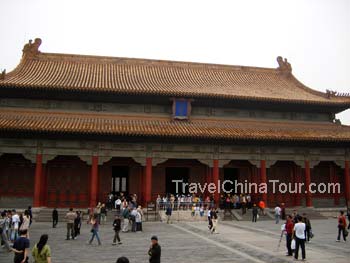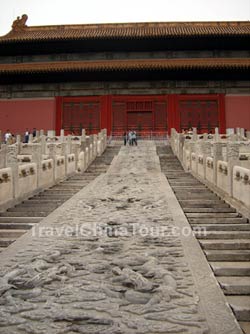Beijing is an ancient city of long history and culture. It's earliest history dates back to 1153 when the Jin Dynasty first established here. You can read more about Beijing History here and here. The three dynasties of Yuan, Ming and Qing, spanning over 800 years have devoted great efforts constructing and reinforcing the capital city Beijing - leaving a long and illustrious history. This long history has left many famous imperial architectural buildings, palaces, and garden in and around Beijing. Some of the most famous are the forbidden palace, Temple of Heaven, Beihai Park, Summer Palace, just to name a few. All of these are what makes Beijing city so unique and Charming.
Beijing Forbidden Palace Museum
The Forbidden City sits at the center of Beijing City, adjacent to the Tiananmen Square. This amazing complex is the perfect example displaying the beauties of ancient Chinese architecture. it was added to UNESCO List of World Heritage in 1987.
Construction of the Forbidden City began in 1406, during the 4th year of Emperor yongle's reign. It took a little over 14 years to complete the construction. Since then, spanning 5 centuries, 24 emperors have lived and ruled China there. The palace is built in a rectangular shape covering 72 hectares. Within the Forbidden City walls, there are 8,704 rooms covering an area of 150,000 square meters. Surrounding the Forbidden CIty are walls that are 10 meters high running a total of 7.24 kms.
Outside of the city walls is a 52 meter wide moat surrouding the forbidden city. Over its 500 plus years of history, the forbidden city has been repaired and rebuilt many times. It's composed of an inner court and an outter court. The outter court was the place where imperial cermonies were held consisting of 3 grand halls: Taihedian (Hall of Supreme Harmony), Zhonghedian (Hall of Complete Harmony), and Baohedian (Hall of Preserved Rear Palaces). Read more about the 3 halls here.

Three main palaces make up the rear court including Qianqinggong (palace of Celestial Purity), Jiaotaidian (Hall of Celestial Union), and Kunninggong (Palace of Terrestrial Tranquility). These are the 3 main courts where the emperor and his family lived. There are also 6 Eastern and Western Palaces, which you can read more about here.
Taihedian is the most magnificent of the 3 Grand Halls. It's 35 meters high covering an area of 2,300 square meters. The floor is paved with 4,718 special bricks known as "Golden Bricks". It's made up of a double-eaved hip roof covered with yellow glazed tiles. This hall was used to hold grand ceremonies when a new emperor ascended the throne. The imperial throne sits in the center of Taihedian. In the middle of the ceiling is a design of a golden dragon with a large pearl.
Zhonghedian stands behind Taihedian. It served as a place of rest for the emperor. The emperor consulted with his religious ministers here. Finally the Baohedian is located the norther most of the 3 Grand Halls. It is smaller than the Taihedian. The Ming Emperors changed into his ritual clothing here. During the Qing Dynasty, this hall was used to hold imperial banquets. On new year's eve, banquests are held here to feast and honor provincial governors, and officials. During Emperor Qianlong's reign the final stage of imperial examinations were also held in the Baohedian. Just outside the north gate of Baohedian, there is a large marble path carved of 9 dragons that weighs 250 tons, and it is the largest stone carving at the forbidden palace museum.

Beijing Imperial Palace - 1
Beijing Imperial Palace - 2
Beijing Imperial Palace - 3
Related Forbidden City Travel Guides:
|